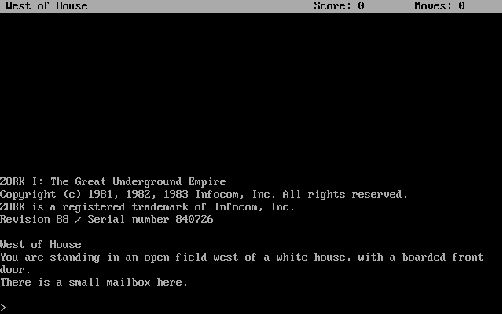Zork 1: The Great Underground Empire
Rating: 4.38 from 5 (based on 13 votes. 👍 10 – users like it, 👎 2 – disliked, 💬 1 – comments posted)
Released: June 2019
Zork 1: The Great Underground Empire is a pioneering text-based interactive fiction game that played a major role in shaping the history of computer entertainment. Created by Tim Anderson, Marc Blank, Dave Lebling, and Bruce Daniels at MIT, this classic adventure immerses you in a mysterious underground world once ruled by the Flathead Dynasty. With no graphics or sound, Zork 1 relies entirely on descriptive storytelling and natural language commands, inviting you to explore caverns, encounter trolls, solve intricate puzzles, and uncover hidden treasures. Each room and item is described in detail, encouraging you to visualize scenes and interact with your surroundings using simple text instructions like “open mailbox” or “go north.” Despite its minimalistic approach, the game offers deep challenges, witty writing, and a captivating narrative that keeps players coming back for more.
Released by Infocom in the early 1980s, Zork 1 quickly gained a devoted following among PC gaming enthusiasts seeking more than just twitch-based arcade action. Its innovative text parser could understand complex commands, making interactions feel surprisingly natural. Rather than relying on fast reflexes, success in Zork 1 depends on careful observation, logical thinking, and creative problem-solving. This intellectual focus turned the game into a cult favorite, especially among university students and fans of the Dungeons & Dragons tabletop tradition. Over time, Zork 1 was split into three chapters (Zork I, II, and III) to fit within the limited memory and storage constraints of early home computers. To solve these technical challenges, Infocom developed the Z-machine virtual machine, which made it possible to run text adventures on numerous platforms while maintaining the same immersive experience.
Playing Zork 1 on PlayMiniGames is a fantastic way to appreciate one of the earliest milestones in retro gaming without any downloads. Simply launch the game in your browser and dive into the Great Underground Empire. Discover secret passages, gather valuable objects like the brass lantern and elven sword, and keep an eye out for the lurking grue, a notorious creature that devours lost adventurers in the dark. The game awards points for collecting treasures and storing them safely in the trophy case within the abandoned white house. You will have to keep track of your inventory weight, ration out your light sources, and even engage in text-based combat with certain foes. The risk of danger adds a sense of urgency to your exploration, and you can save or restore your progress at any time, ensuring you can experiment freely with different approaches.
Zork 1 is often praised for its entertaining writing, clever humor, and detailed world-building. Though it requires a decent command of English to fully enjoy, the payoff is well worth the effort. You will encounter puzzles that demand lateral thinking and keen observation, with even the smallest descriptive clue potentially guiding you toward a breakthrough. The game does not hold your hand, but it rewards persistence, curiosity, and a willingness to interpret cryptic messages. Its timeless design has allowed Zork 1 to remain relevant despite the absence of modern graphics or sound. In fact, its reliance on text makes it endlessly adaptable, surviving on new platforms and even browsers many decades after its initial release.
If you are ready for a nostalgic journey or a first-time foray into interactive fiction, visit PlayMiniGames to experience Zork 1: The Great Underground Empire. Step into the shoes of an adventurous explorer, gather treasures, navigate perilous dungeons, and put your logical thinking to the test. Whether you are an old-school gamer revisiting classic gems or a newcomer curious about the roots of modern adventures, this groundbreaking title will challenge, amuse, and surprise you. Good luck on your quest, and watch out for any dark corners, because you never know when the grue might be lurking. Enjoy exploring this piece of gaming history and immerse yourself in a world where your imagination truly takes center stage. ✨⚔️✨

kittytoe
- 02-03-2021 14:29:07